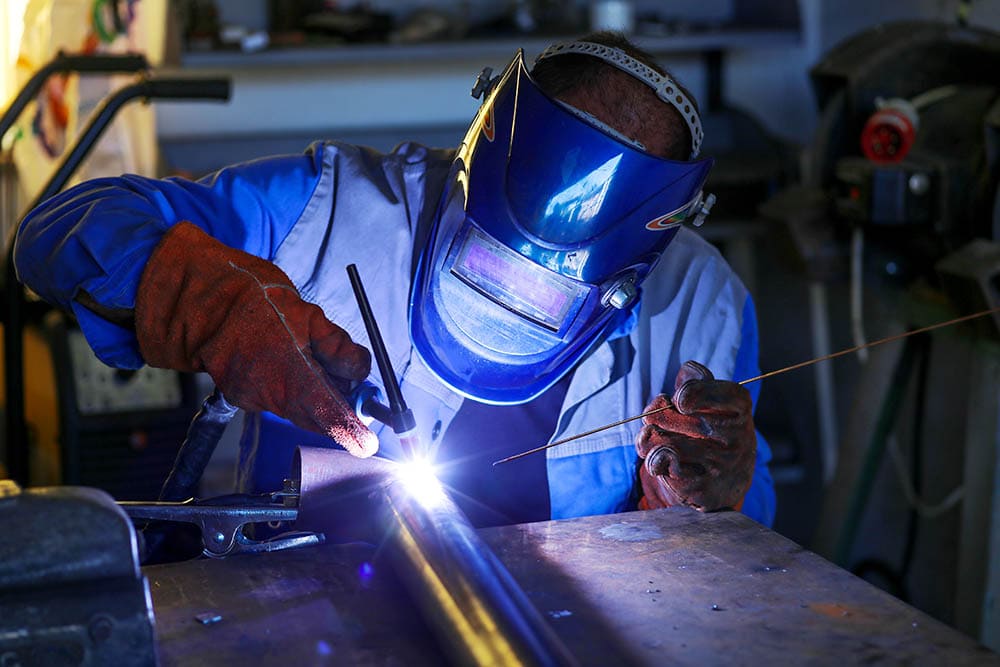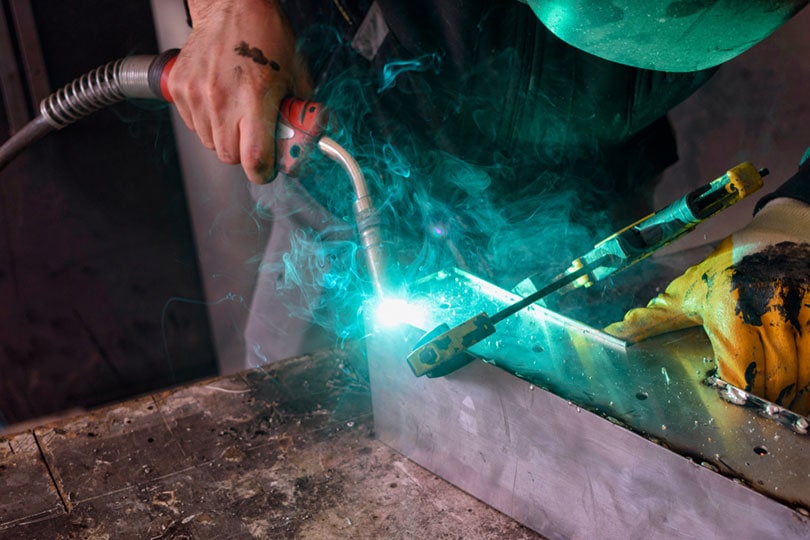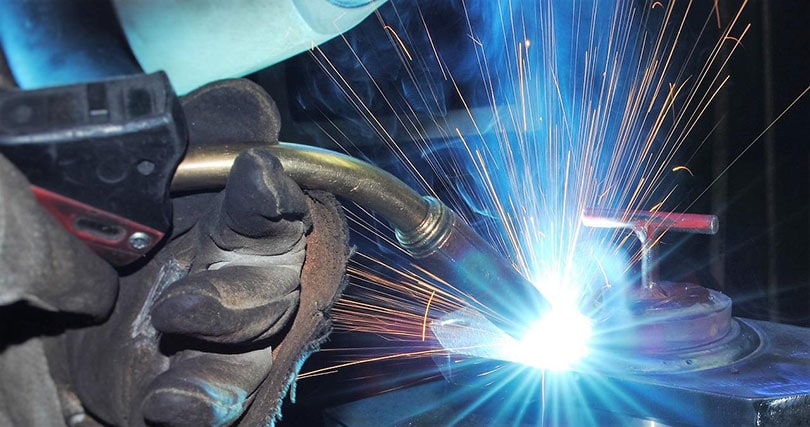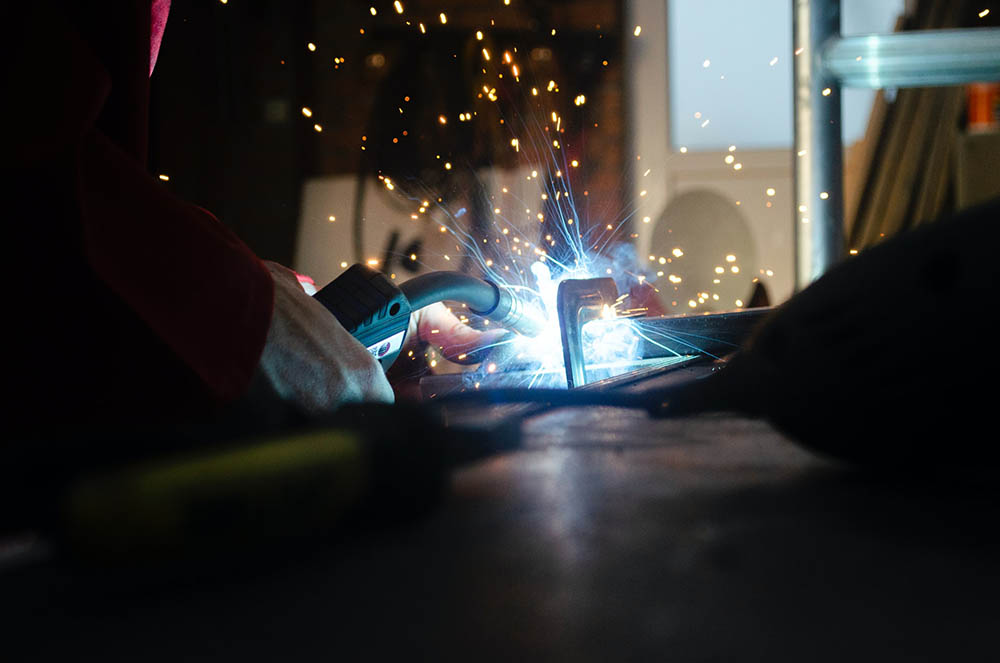MIG Welding for Beginners: 7 Tips & Tricks to Get You Started
Last Updated on

With the pull of a trigger when you drop your hood, MIG welding is easily the most practical welding process. The bright arc makes it easy to see your puddle (unlike TIG), and you don’t have to constantly reload electrodes into a stinger (like SMAW). As anxious as you are to start welding, there are a few things you should know before you start. Here are a few tips and tricks to help you out.
The 7 Tips & Tricks for Beginner MIG Welding
1. Get in Your Comfort Zone
Aside from machine settings, comfort is probably the number one contributing factor to a successful weld. If you are not comfortable, you will not produce quality work. Only after a lot of practice welding comfortably can a welder then weld in uncomfortable positions, which is out of necessity. If you are just starting to MIG weld, you probably have a workspace in your garage. Get a stool that doesn’t hurt your back, and find materials to lean on. Make sure you have good ventilation and keep a water bottle next to you. This is the first and easiest step to take before beginning to weld.

2. Watch Your Travel Angle
The key with MIG is to not go too extreme in either direction. Ideally, you will be almost at 90° with the workpiece with a very slight push angle, maybe 5°. But dragging is acceptable, and some people prefer it since it creates better joint penetration.
With flux-core, you almost always drag because of the slag that results, but with MIG, you don’t have to worry about the slag. Instead, gas coverage is the bigger issue with too extreme of an angle. If you tilt your gun too far in one direction, the shielding gas will not be directed toward the weld zone on the material’s surface but will be pointed away from it. This can easily result in porosity and undesirable weld appearance. Find out what is most comfortable for you. A slight push is usually preferred because it typically produces a nice flat bead appearance.
3. Make Sure Your Gas is On
Making sure your shielding gas (75/25 argon/carbon Dioxide mix for short arc) is on and that you have enough of it is vitally important. It’s not enough to just open the gas cylinder and expect smooth sailing. Ensure that you’ll have enough coverage; it will depend on the inside diameter of your gun nozzle. Also, ensure that you don’t have too much gas. If you have too much gas, the puddle will be unstable, and you will still get porosity.
4. Let it Fry
While too many welders think of themselves as more artistic than is permissible for practitioners of a craft based on facts and physics, the proper setting for short arc on the machine can usually be judged as good or bad based on the sound of the weld. It should sound like frying bacon!
A nice sizzle with crackling sound means that your voltage and wire speed are set just right. Now, you will have to fine-tune it a little bit. The right amount of wire but with too low of voltage will give you a popping and sputtering weld that piles up in globs. The right voltage with too little wire will sound like an infrequent hissing. However, if your weld sounds like a continuous crackling (like bacon), you’re in good shape.

5. Keep a Log of Machine Settings
You can use the machine manufacturer’s recommendations. Sometimes they will be posted on the side of the machine, but if they aren’t, you can usually find them in the manual. The recommendations are merely a starting point, and since every project is different, you’ll find that there are certain settings that you like. As long as you are within reasonable parameters, you can alter your settings. You’ll know you’ve wandered too far away from the proper parameter range when you start seeing defects. Is your weld too concave? Maybe your voltage is too high. It’s okay to tinker with settings, but when you find that sweet spot, write down the settings! If you don’t, you’ll come back to that machine the next day and be kicking yourself because you or someone else changed it. Keeping a small log of your settings will help prevent this.
6. Try Oscillating
Something that is especially helpful when you’re starting out is using an oscillation technique to lay beads. This means that instead of keeping your arm perfectly still while moving the weld, you move the welding gun in a particular pattern to keep the weld consistent. It’s hard to keep your arm still, even if you have something to lean against to stabilize your movement.
Turn that third cup of coffee jolting through you into something useful and oscillate by making lowercase e’s or curls with the wire. You can also lay a “stack of dimes,” as they call it by making a slight movement back and forth. This is not just a matter of being unnecessarily creative; it serves a practical function. When you oscillate, you also help the weld wet out on both edges of the joint, thereby ensuring proper fusion. Just don’t move too suddenly.

7. Always Clip off Your Wire
What’s the harm in striking an arc with a small glob on the end of your wire? It’s just going to end up in the weld anyway, right? Wrong. Very often, it will pop and explode all over your table and you. Just clip your wire, and it will save you some trouble by giving you a clean slate with each new weld you make.
If you don’t clip off your wire, you also run the chance of pieces of wire geting stuck in your weld. So, get in the habit of clipping your wire or even striking a brief arc on a piece of scrap metal to produce a clean tip on your wire.
Final Thoughts
Even though “the feel” is an unknown quantity and we are dealing with real metrics in welding, there is a lot to be said for the welder’s feel of the machine, how the weld sounds, and body positioning. You might not have this spidey sense in the beginning, but it will develop with time. Start by following established parameters, and when you start to feel more naturally comfortable, you can make your own decisions as needed.
Beginner Tips & Projects:
- 12 Easy Welding Projects for Beginners to Try Today (With Pictures)
- TIG Welding for Beginners: 14 Tips & Tricks to Get You Started
- Flux Core Welding for Beginners: 7 Tips & Tricks to Get You Started
Featured Image Credit: Marina Lohrbach, Shutterstock
